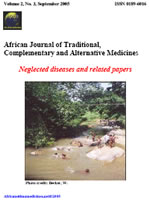
|
African Journal of Traditional, Complementary and Alternative Medicines
African Ethnomedicines Network
ISSN: 0189-6016
Vol. 4, No. 4, 2007, pp. 417 – 426
|
 Bioline Code: tc07059
Bioline Code: tc07059
Full paper language: English
Document type: Research Article
Document available free of charge
|
|
|
African Journal of Traditional, Complementary and Alternative Medicines, Vol. 4, No. 4, 2007, pp. 417 – 426
| en |
CHEMICAL COMPOSITION, CYTOTOXIC ACTIVITY AND ANTIMICROBIAL ACTIVITY OF ESSENTIAL OILS OF LEAVES AND BERRIES OF JUNIPERUS PHOENICE  A L. GROWN IN EGYPT. A L. GROWN IN EGYPT.
El-Sawi, Salma A.; Motawae, Hemaia M. & Ali, Amal M.
Abstract
Hydrodistillation of berries and leaves of Juniperus phoenicea grown in Sinai yielded volatile oils in the yield of 0.36 and 1.96%, respectively. Using gas chromatography/mass spectrometry technique, fifty eight compounds were identified in berry oil representing 99.2% of the oil composition. α-Pinene was the major compound in berry oil (39.30%) followed by sabinene (24.29%). Berry oil composed mainly of monoterpenoids which amounted to 90.53%, of which 72.85% was monoterpene hydrocarbons. The sesquiterpenoids accounted for about 8% of the total oil composition. Leaf oil was composed of about 66 compounds representing 99.16% of the total composition of the oil. α-Pinene was the major constituent of leaf oil at concentration of 38.22%, followed by α -cedrol (31.23%). The monoterpene hydrocarbon was the predominant chemical group (41.29%) followed by the oxygenated sesquiterpenes (32.21%). Both oils showed very high cytotoxic activities against all cell line tested. They showed equal activities against brain (0.6 μg//ml) and cervix (5.0 μg//ml) human cell lines, while berry oil was slightly more active than leaf oil against lung (0.6 and 0.7 μ/ml, respectively), liver (0.7 and 0.9 μg//ml, respectively) and breast human cell lines (0.8 and 1. μg//ml, respectively).The antimicrobial activity and minimum inhibitory concentration (MIC) of leaf and berry oils were also determined. The oils showed high activity against most of the tested strains.
Keywords
Juniperus phoenicea, Cupressaceae, essential oils, berries, leaves, antimicrobial, cytotoxic, GC-MS analysis.
|
| |
© Copyright 2007 - African Journal Traditional, Complementary and Alternative Medicines
Alternative site location: http://journals.sfu.ca/africanem/index.php/ajtcam
|
|
